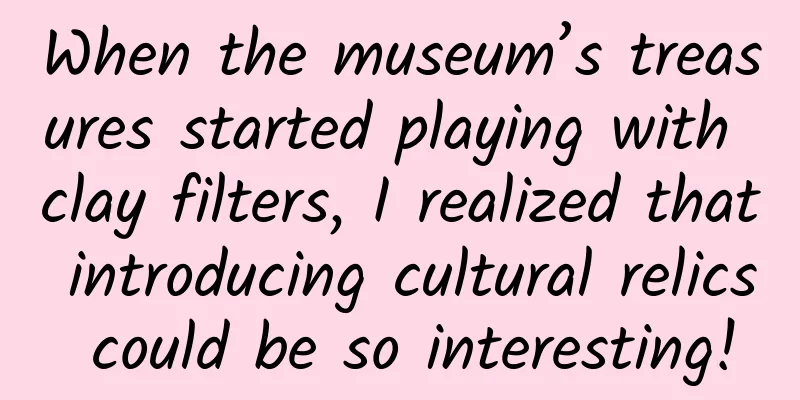When the museum’s treasures started playing with clay filters, I realized that introducing cultural relics could be so interesting!

|
Recently, the "clay filter" has been very popular Brings you an extra interesting visual experience The photos with filters not only look cute It's like entering another world … So, when artifacts meet clay filters What kind of sparks will be created? In this issue, we will take you on a fun tour of the museum Check out these treasures of the museum How to create a magical effect~ Chongqing Ba People Museum Qing Dynasty Pine Crane Peony Vase The bottle is 92cm high, 115cm in girth, 32cm in diameter, 31cm in bottom diameter, with a wide mouth and narrow neck. There are two dragons on the neck and ears on the side of the neck. The bottle is decorated with peony, pine tree and crane. Peony represents wealth, pine tree and crane represent longevity, implying "wealth and longevity". Chongqing China Three Gorges Museum Warring States bird-shaped zun Image source: Chongqing China Three Gorges Museum It was unearthed in the Xiaotianxi Cemetery in Fuling in 2002. It is 28cm long, 16.8cm wide and 29cm high. It is bird-shaped, with a fish mouth, eagle beak nose, animal ears, phoenix crown, pigeon body and duck feet. The whole body is decorated with fine honey feather patterns, and turquoise is regularly inlaid on the feather patterns. The shape, patterns and decoration are extremely exquisite. The bronze zun was originally a wine vessel. Except for the fish-shaped mouth, this zun has no holes on the whole body and does not have the practicality of a container. It should be made by learning from the bird and animal zun in the Central Plains. It is light, thin-walled and hollow, and it is extremely difficult to cast. It was unearthed from the noble cemetery of the Ba people. It is a rare art masterpiece for studying the aesthetic taste, craftsmanship and casting technology of the Ba people. The cultural relic is currently on display in the "Ancient Ba Yu" exhibition hall of the China Three Gorges Museum in Chongqing. Shaanxi History Museum Tang Sancai figurine of a camel carrying music Image source: Shaanxi History Museum The camel stands on a rectangular base, stretching its neck and neighing. The pack frame on the camel's back is a platform covered with colorful blankets. There are eight musicians in total. Seven of them are male musicians wearing Hanfu, holding different Hu instruments, sitting cross-legged facing outwards and playing. There is a standing woman in the middle singing. It is obvious that this is a mobile performance troupe. The artists of the Tang Dynasty used a romantic method to set the stage on the camel's back, which can be said to be ingenious. The openness of the Tang Dynasty welcomed people from all over the world. The various rare treasures they brought made the people of the Tang Dynasty love them; the exotic music and dance they brought made the people of the Tang Dynasty happy. Gansu Provincial Museum Bronze Galloping Horse Image source: Gansu Provincial Museum The bronze galloping horse is 34.5 cm tall, 45 cm long, 13.1 cm wide and weighs 7.3 kg. It is sturdy and exquisitely shaped, with its head held high and neighing, and galloping at full speed. The three legs of the galloping horse are in the air, and the whole body's focus is on one leg that surpasses the flying bird. It accurately grasps the principle of mechanical balance and has an excellent level of craftsmanship. Nanjing Museum Golden Beast Image source: Nanjing Museum The golden beast is 17.5 cm long, 16 cm wide and 10.2 cm high. It was unearthed in 1982 from the Nanyaozhuang cellar in Xuyi County, Jiangsu Province. It can be traced back to the Western Han Dynasty at the latest. The overall shape is bent and rounded, with an alert look, an empty belly and thick walls, cast into shape, and the whole body is hammered with circular patterns. The words "Huang Liu" are engraved on the inside of the belly. The golden beast contains 99% gold and weighs 9,100 grams. It is the heaviest ancient gold casting unearthed in my country so far and is called the "Treasure of Protection". Henan Museum Spring and Autumn Lotus Crane Square Pot Image source: Henan Museum The Lotus and Crane Square Pot was unearthed in 1923 from the Tomb of the King of Zheng State in Xinzheng. It is 117 cm tall and weighs 64.28 kg. The pot body is oval, with two dragon-shaped monsters looking back on both sides of the neck forming ears. Four pterosaurs around the abdomen seem to be slowly crawling upwards, and two curled-tailed monsters at the bottom with their mouths open and tongues sticking out and looking back sideways seem to be doing their best to support the pot body. The most exciting part is the double-layer lotus petals blooming on the top of the lid, and a crane stands in the center, ready to sing and spread its wings, which was praised by Mr. Guo Moruo as "a symbol of the spirit of the times." The Book of Songs records "hundreds of pots of clear wine". As a type of ancient bronze wine vessel, pots were often used in major events such as ancestral temple sacrifices and banquets. The Lotus and Crane Square Pot is tall and beautifully decorated. It is not an ordinary wine container. It is likely to be a display item of the king of Zheng State, a symbol of the owner's status, wealth and power. Shanghai Museum Spring and Autumn Period Zi Zhong Jiang Plate Image source: Shanghai Museum The Zi Zhong Jiang plate has a square lip, folded edge, shallow belly, and a ring foot at the bottom, with three curled-tail tiger feet attached below. The plate wall has prominent curved patterns, and the inner side is a plain circle. In the center of the plate stands a round male water bird, which is arranged in concentric circles outward. The first circle is two frogs and two turtles in relief, the second circle is four three-dimensional fish, the third circle is four three-dimensional female water birds with turtles and frogs, and the fourth circle is three three-dimensional frogs and seven relief fish. All the three-dimensional animals in the plate can rotate 360 degrees. This artistic expression method has never been seen before, showing the progress of casting technology in the early Spring and Autumn Period. The bottom of the plate is inscribed with 32 characters in 6 lines. The inscription roughly means that on the first day of the sixth lunar month, the master made a wash basin for his wife, Zi Zhongjiang. The basin is large and good, and is used to pray for longevity. It is treasured by future generations. The basin is an ancient Chinese wash basin used to hold water, and is usually paired with a yi. The Zi Zhongjiang yi that is paired with this basin is now in a private collection in the United States. Source: Chongqing Jiulongpo District Cultural Relics Management Office Audit expert: Chen Tao Source: Chongqing China Three Gorges Museum, Shaanxi History Museum, Gansu Provincial Museum, Nanjing Museum, Henan Museum, Shanghai Museum Image sources: Chongqing China Three Gorges Museum, Shaanxi History Museum, Gansu Provincial Museum, Nanjing Museum, Henan Museum, Shanghai Museum Statement: Except for original content and special notes, some pictures are from the Internet. They are not for commercial purposes and are only used as popular science materials. The copyright belongs to the original authors. If there is any infringement, please contact us to delete them. |
<<: Why do rubber bands turn cold and purple when they are tied around fingers?
Recommend
How to promote and attract traffic to Douyin store?
Many merchants who sell things on Douyin have ope...
Enhancing content and usability is the key to the Internetization of color TV enterprises
Internet companies want to seize new entrances by...
How can a brand create IP if it wants to break through?
A good corporate brand IP should be able to inher...
It has been prevalent recently, so be extra careful!
Recently, the high temperature and high humidity ...
Pinduoduo, can’t escape from vulgar marketing?
Today while surfing I saw a message saying: Open ...
Thanks to Aion S, GAC New Energy has single-handedly raised the electric vehicle range to 500KM
"What does it mean to have a range of 510km ...
The bus driver who fell into the lake in Guizhou had posted a singing video. He had posted a singing video 2 days before the incident. His former colleagues said he was a very good person!
Recently, a bus fell into a lake in Guizhou. Neti...
Tutorial on using TensorFlow on iOS (Part 1)
Before using deep learning networks for predictiv...
Elderly care robots are here! They can make tea, feed cats, practice Wing Chun, play the piano, flip the spoon and play mahjong
Author Li Chuanfu Elderly care robots are here! S...
Using 0.2 grams of lunar soil, they discovered a major secret
When conducting the first experiment with lunar s...
Todd "Attraction Unlocked" Baidu Cloud Download
Introduction to the video tutorial of the pickup ...
Why can’t Douyin influencer promotion be charged based on results?
Whether it is performance advertising or brand ad...
220 million box office in 3 days: Why is "See You Tomorrow" so popular?
Han Han's "See You Tomorrow" box off...
The third generation Honda CONNECT is officially launched
On March 22, Honda Motor (China) Investment Co., ...
How to compile iOS projects 5 times faster
Preface Beiliao currently develops two apps, Beil...









